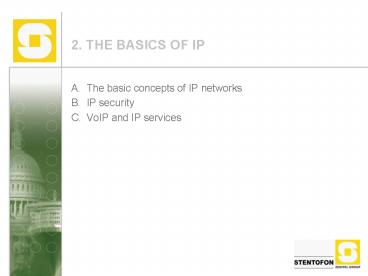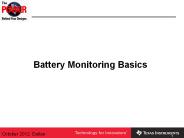2' THE BASICS OF IP - PowerPoint PPT Presentation
1 / 22
Title:
2' THE BASICS OF IP
Description:
DSL, Cat5, Ethernet, optical, wireless, ATM, frame relay, ... As default, the strictest configuration is set in AlphaCom. Traffic screening (internal firewall) ... – PowerPoint PPT presentation
Number of Views:69
Avg rating:3.0/5.0
Title: 2' THE BASICS OF IP
1
2. THE BASICS OF IP
- The basic concepts of IP networks
- IP security
- VoIP and IP services
2
A. The basic concepts of IP networks
- IP provides
- Communication for any service
- Web, email, file sharing, telephony, TV, logging,
administration, CCTV - Over any network infrastructure
- DSL, Cat5, Ethernet, optical, wireless, ATM,
frame relay, satellite, leased lines, ISDN dialup
3
LAN/WAN
WAN links are always a scarce resource
4
WAN Networks Service Providers
ISPs sell WAN links and Internet Access
Internet
Broadband Access (DSL/Cable)
5
WAN Networks Virtual Private Networks
VPN Virtual Private Network Technology to
connect LANs so they operate as one LAN Can
operate over Internet IPsec is a technology to
provide encrypted VPNs Firewall implements (do
you not mean protects)VPNs and IPsec
Broadband Access (DSL/Cable)
VPN
IPsec
6
Own managed WAN Leased line
Expensive (2X) Privately managed Typically Frame
relay or ATM
7
Owned managed WAN Fibre
London
Ethernet - Low equipment cost, high bandwidth
ATM - High equipment cost, high bandwidth
8
Local Area Networks
- Networks from simple to
- Simple networks
9
Larger Local Area Networks
Logical set-up Sets the parameters for the
services - bandwith to use - who is talking to
who, etc.
Physical Route
10
B. IP Security
- Overview of IP protection mechanisms
- Network/Site Perimeter Protection
- Internal and Traffic Protection
- Node Protection
- AlphaCom IP security mechanisms
11
i. Overview of IP protection mechanisms
- Network/Site Perimeter Protection
- Internal and Traffic Protection
- Node Protection
- Defense of depth principle
- Employment of several security mechanisms and
security layers to provide maximum protection.
12
Perimeter/Site Protection
Physical network/site perimeter
Firewalls
Private (hidden) addr
Trusted domain
Untrusted domains
Trusted domain
Residential
networks
13
Internal and Traffic Protection
Communication
Communication
protection
protection
Network separation
OM
network
Enterprise
Remote
Enterprise
Enterprise
Residential
networks
site
networks
networks
Internet
Internet
networks
networks
Internet
Internet
networks
networks
ITSP
ITSP
ITSP
ITSP
Untrusted domain
Untrusted domain
14
Node Protection
Residential
Residential
Residential
Residential
15
ii. AlphaCom IP Security mechanisms
- Administrative access
- Logon with password
- Separate management interfaces
- IP services for management
- Web http
- AlphaPro
- Telnet
- AlphaCom data protocols
- Security-by-default
- As default, the strictest configuration is set in
AlphaCom
- Traffic screening (internal firewall)
- Internal firewall to screen IP services pr
interface - Limited number of ports opened for AlphaNet and
SIP enables port screening between networks - AlphaNet and SIP calls always go via AlphaCom
exchanges enabling screening on source and
destination - AlphaCom as DMZ proxy node
16
C. VoIP
- VoIP and IP services
- VoIP equipment
- Quality of service (QoS)
- OoS and voice quality
- QoS and network availability
- OoS and VoIP bandwidth management
17
i. VoIP and IP services
- VoIP
- audio and signaling
- IP services
- Web
- Logging
- Administration
- IP QoS
- IP security
STENTOFON AlphaCom E IP intercom
18
ii. VoIP equipment
- Exchange (Call Server, gatekeeper, call manager,
proxy server, iPBX, AlphaCom E) - VoIP telephones and stations
- PC clients
- Telephone adaptor (ATA)
- Voice network gateway (PBX or public network)
19
iii. Quality of Service (QoS)
- QoS is the ability of a network to service a
given application efficiently, without affecting
its function or performance - QoS subjects to be covered
- QoS and voice quality
- QoS and network availability
- QoS and VoIP bandwidth management
20
QoS and voice quality
- Voice quality
- Sound quality (loudness, distortion, frequency,
noise) - Conversation quality (end-to-end delay,
crosstalk, echo,) - Robustness (silence suppression, echo canceller,
background noise) - QoS factors affecting voice quality
- Network Availability
- Bandwidth
- Delay and delay variation (jitter/wander)
- Packet loss
21
QoS and network availability
- The traditional benchmark for a voice network
- 99.999, or about 5.25 minutes of downtime per
year. - Design availability
- Equipment reliability
- Network survivability
- Power distribution (UPS, battery)
- Redundant links multiple options of completing
a call - Switchover support
- Local intelligence
- IP QoS
- IP security
- Service provider selection and QoS Service Level
Agreements (SLAs)
22
QoS and VoIP bandwidth management
AlphaNet limits and manages the number of VoIP
channels between exchanges and WAN links































